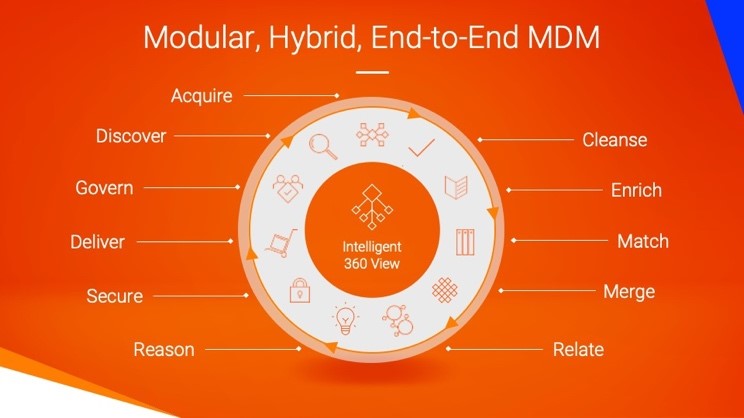Four Critical Success Factors to Deliver Rapid Business Value with Your Master Data Management Implementations
Taking A Modern Approach So Your MDM Implementations Aren’t Lengthy, Difficult, or Costly

Master Data Management (MDM) implementations have successfully delivered value across nearly every industry, sector, and geography. MDM has been a staple in data architectures for over 20 years and is recognized as a mature technology—but that doesn’t mean it’s stopped evolving.
What is Master Data Management?
Organizations invest in master data management solutions in order to create a master record, or the best version of truth for core data that spans multiple domains (such as customer, product, supplier, finance, or location). MDM provides capabilities to cleanse, enrich, match, merge, govern, and deliver authoritative data to applications, systems, and individuals that rely on clean and consistent data to support both analytical and operational processes.
MDM solves the challenge of inconsistent, incomplete, and inaccurate data that results from different formats and definitions across a wide variety of siloed systems and sources; where each system is built-for-purpose and typically not designed to maintain the quality of data within it. For example, a billing system may only have a billing address and not a shipping address. A marketing campaign system may only have an email address and not a phone number.

Master Data Management Implementations, Then and Now
When MDM was first introduced, implementations followed a phased approach, one that began with analysis and design, followed by build, test, and finally deploy. MDM was seen as a significant investment in both time and resources, with delivered business value measured in years and over multiple phases. Often during this time, business priorities had the potential to change and the project would be even more challenged to deliver on the original objectives. However, this approach resulted in a perception that MDM is a long-term, complex, and costly project.
To minimize the cost, timeline, and risk associated with MDM implementations, organizations looked for an approach that would simplify and accelerate delivery.
Critical Implementation Success Factors
There are four critical success factors for any MDM implementation:
- Enterprise Thinking
The team needs to be willing to break down silos and work across business units. Success requires the backing of senior management to make changes across the organization and to start the process of thinking at enterprise level. Find an executive sponsor who will champion the big picture and align priorities across teams.
2. Business Vision & Business Case
Defining the business case for an MDM initiative is especially important as MDM tends to be an enabler of business value rather than delivering immediate, direct value to the business. Be clear in your vision. Vague goals and an over-ambitious scope will create ambiguity and cause the project to flounder. The most successful MDM efforts tie the program to a specific, measurable set of business goals, objectives, and KPIs related to revenue, cost, and engagement.
3. Use Case Roadmap
Customer experience, application modernization and digital transformation initiatives are examples of corporate strategies that need MDM to reach their full potential. As these initiatives are often journeys themselves, it’s essential to support the long-term vision by breaking them down into smaller, achievable steps that provide quick wins. Build a roadmap of use cases that allow you flexibility to adjust to changing business climate, yet still deliver value every few months. The first project should start small and provide the ability to expand quickly into the next, additive use case. Aim to deliver real value that can be heralded as a huge success across the organization.
4. Communication Planning
An effective communications plan must regularly address the progress, changes, and successes of the initiative. Successes should include not only the status of the project timeline and quantified metrics identified in the initial business vision, but any anecdotal benefits and unexpected value that can be measured and quantified. Successful data management projects are more likely to gain widespread adoption across the enterprise if people know about them and are informed on an ongoing basis.
An Accelerated Approach to MDM Implementations
To deliver shorter, more agile implementation timeframes, Informatica came up with a new approach by identifying common requirements across hundreds of MDM customers and implementations. Based on these requirements, Informatica designed and built MDM 360 applications to simplify and accelerate delivery of MDM for the most common domains of customer, reference, product, and supplier.
Another opportunity to successfully accelerate your MDM program is to start with data that is of high quality. An application approach addresses data quality from the beginning through standardized, templated rules (build once, deploy anywhere). Data is profiled, cleansed, standardized, and validated with visual mapping and scorecards in order to ensure clean, consistent, and accurate master data.
Case Study
A UK bank had been challenged with identifying and collating data required for decision-making. They were unable to identify relationships across business units and lacked a single customer view.
Following a 12-week focused delivery plan, the bank worked with Informatica Professional Services to design and deliver a data management process underpinned by the Informatica MDM – Customer 360 solution. The data management process was designed to gather customer data from three key data sources in Azure through Informatica Data Quality (IDQ) and then MDM. Once the records were matched and merged, they were published and transformed back to Azure, ready for analysts to draw from on a daily basis. The initial 12-week delivery was then expanded into other departments which required an additional four weeks for user testing.
By connecting three sources which had never before been connected, the joint team was able to deliver a single view of the customer through a solution that takes advantage of robust and scalable governance to support data stewards. This enabled the bank to provide business value across departments, improve its understanding of their customers and deliver high-quality master data to credit teams in their daily decisions.
To learn more about Informatica’s accelerated approach, watch this video.








